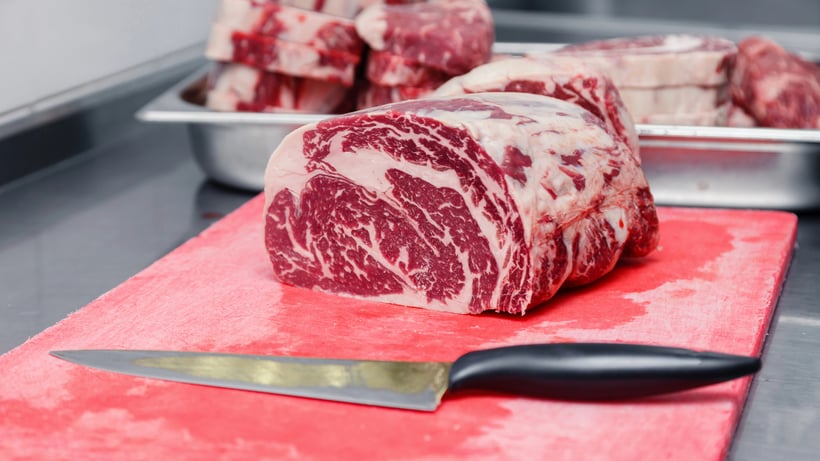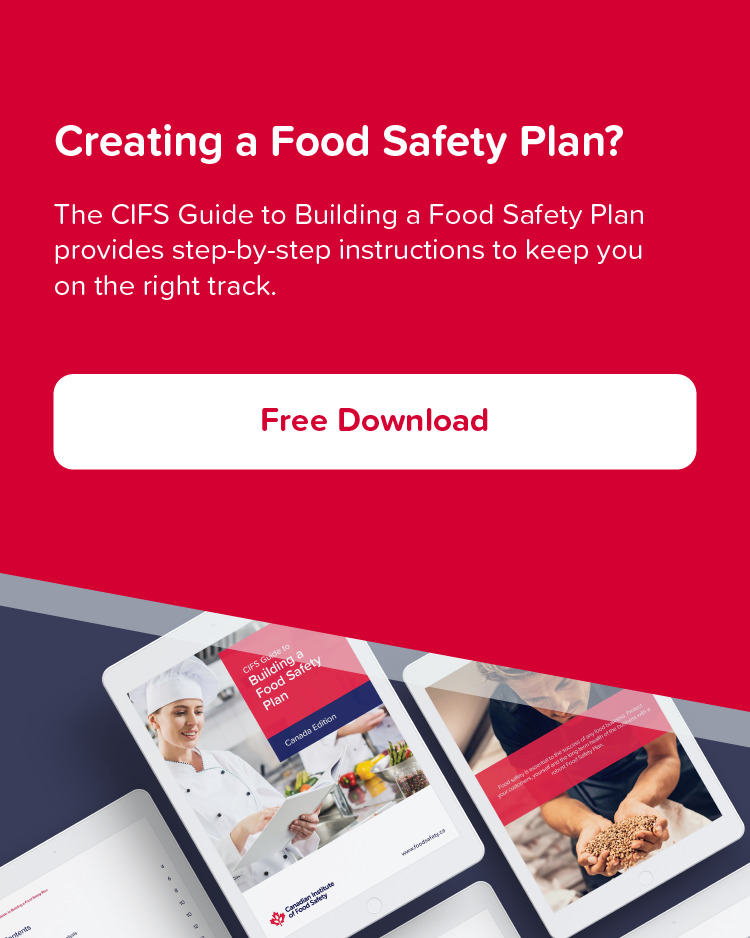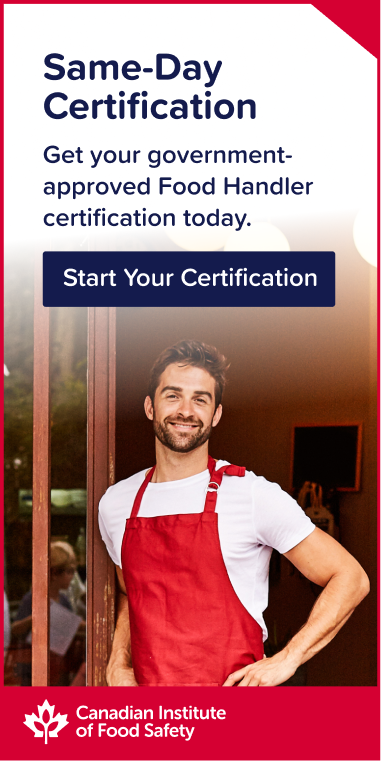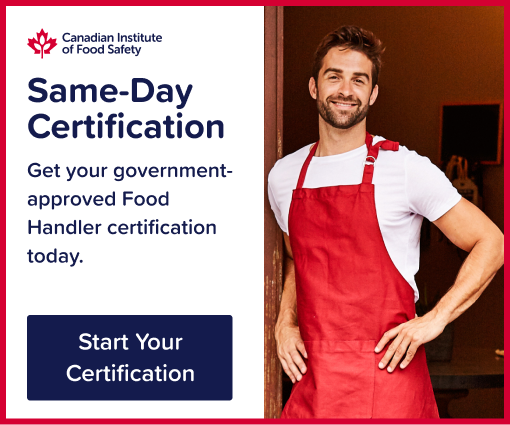
Whether you own, manage or work at a food business – or if you’re preparing and serving food at home – it's important to understand what the potential food safety hazards and risks are. Food contamination is one such risk.
In this blog, we discuss what food contamination is, its types and sources, plus the steps you can take to prevent it—including completing the Food Handler Certification Course.
Contents:
How to prevent food contamination in your business
What is food contamination?
Food contamination refers to when something gets into food that shouldn't be there, thereby making the food unsafe to eat. Food-borne illness and its business-destroying cousin, the food-borne illness outbreak, are caused by food contamination.
While there are many food safety hazards that can cause food contamination, most fall into one of three categories: biological, physical or chemical contamination. In many cases, a single hazard can introduce more than one type of contamination to food.
Types of food contamination
BIOLOGICAL CONTAMINATION
Biological contamination occurs when food becomes contaminated by living organisms or the substances they produce. This includes biological matter produced by humans, rodents, insects and microorganisms. Biological contamination is the leading cause of food-borne illness and food poisoning*, and a common cause of food spoilage and food waste. There are six types of microorganisms that can cause food-borne illness: bacteria, viruses, parasites, protozoa, fungi and prions.
Most food-borne illnesses in Canada are caused by bacteria or viruses, with the most common being:
- Norovirus
- Listeria
- Salmonella
- E. coli
- Campylobacter
Food-borne illness occurs when disease-causing microorganisms, also called pathogens, get into food and multiply to unsafe levels before being eaten. This can happen remarkably quickly; in conditions ideal for bacterial growth, one single-cell bacteria can become two million in just seven hours.
Bacteria and other pathogens thrive in foods that are:
- Moist
- High in protein or starch
- Neutral in acidity
Foods that meet these criteria are called potentially hazardous or high-risk foods. All high-risk foods are teeming with pathogens and other bacteria; it is your responsibility to stop bacteria from multiplying to unsafe levels and, where possible, to destroy them via the cooking process.
To slow down the growth of bacteria and prevent food safety risks, you need to follow food safety best practices designed to control bacterial growth through proper food handling techniques, rigorous cleaning and sanitizing procedures and time and temperature control of food.
Food poisoning occurs when specific toxins are consumed, such as those produced by Salmonella, Staphylococcus or Listeria. Microbial toxins are extremely potent toxins that can disable the immune system and damage tissues if they are consumed. Many microbial toxins are heat-resistant, so even if bacteria are destroyed in the cooking process, the toxins remain in the food and can cause violent, almost-instantaneous symptoms.
To minimize the risk of biological food contamination occurring in your food business, always:
- Keep high-risk foods (e.g. meat, poultry, dairy, eggs) out of the Temperature Danger Zone**
- Purchase, store, thaw, prepare, cook and serve high-risk foods properly
- Regularly clean and sanitize all food contact surfaces and equipment
- Maintain good overall hygiene and sanitation of the premises
- Maintain high standards of personal hygiene (and ensure all employees do the same)
*The terms “food-borne illness” and “food poisoning” differ slightly in meaning but are often used interchangeably to describe any food-related illness caused by microorganisms or their byproducts.
**In Manitoba, the Temperature Danger Zone is 5°C – 60°C (41°F – 140°F). In all other provinces and territories in Canada, it is 4°C – 60°C (40°F – 140°F).
PHYSICAL CONTAMINATION
Physical contamination occurs when a physical object enters food at some stage of the production or preparation process. Physical objects in food can be a choking hazard and often introduce biological contaminants as well. Even if the object is not likely to injure your customer, finding an object in their food can be very distressing for a customer (who knows that harmful microorganisms on the object could make them ill).
Common examples of physical contaminants in food businesses include:
- Hair
- Fingernails
- Bandages
- Jewellery
- Broken glass, staples
- Plastic wrap/packaging
- Dirt from unwashed fruit and vegetables
- Pests, pest droppings, rodent hair
To minimize the risk of physical food contamination occurring in your food business, always:
- Wear hair neatly tied back or wear a hair/beard net
- Keep jewellery to a minimum
- When necessary, wear brightly coloured bandages that can be easily seen if they fall off
- Throw out and replace cracked, chipped or broken dishware, glassware and equipment
- Use a plastic or metal scoop for ice (never use the glass!)
- Wash fruits and vegetables thoroughly
- Establish pest prevention and control procedures as part of your Food Safety Plan
.jpg?width=2000&height=1125&name=Adobe%20Express%20-%20file%20(5).jpg)
CHEMICAL CONTAMINATION
Chemical contamination occurs when food produces or comes into contact with toxic chemicals, which can lead to chemical food poisoning. Chemical contaminants fall into one of two categories: natural and artificial.
Common chemical contaminants include:
- Cleaning products (e.g. detergent, sanitizer)
- Pesticides/herbicides
- Toxic chemicals in metals and plastic
- Preservatives
- Naturally-occurring toxins
Naturally-occurring toxins are toxic compounds that are produced by living organisms, some of which are staples of the human diet (e.g. shellfish, potatoes, fish). These toxins are not harmful to the organisms themselves but can be harmful to us if we eat them.
Minimal contamination with natural toxins might not lead to illness, but Food Handlers should be aware of which foods produce toxins and take all reasonable precautions to ensure that food is safe for consumption. Potatoes, for example, produce glycoalkaloids that are toxic to humans. The majority of these toxins are contained in or just under the peel, and in any eyes or sprouts on the potato. Green skin can indicate the presence of toxins, so be sure to remove any eyes, sprouts or green skin if you decide to use potatoes that have greened or sprouted.
There are many ways that food can become contaminated by artificial/synthetic chemicals in a commercial kitchen. Food Handlers can accidentally cause chemical contamination if they:
- Don't store cleaning products and other chemicals properly
- Use too much detergent or sanitizer to clean food preparation surfaces, glassware, dishes or cutlery (follow the manufacturer's instructions!)
- Don't rinse surfaces, glassware, dishes or cutlery properly after cleaning and sanitizing (if applicable)
- Don't properly wash fruits and vegetables to remove pesticides
- Use kitchen equipment or containers made from materials that are not suitable for food or not designed to be reused (use only food-grade plastic and metals)
- Use pest control products (e.g. spray, poisonous bait) improperly
To minimize the risk of chemical contamination occurring in your food business, always:
- Label and store chemicals separately from food
- Use the appropriate chemical for the job you're doing
- Follow the chemical manufacturer's instructions with regards to dilution, contact time and water temperature
- Use chemical pest control products with extreme care or outsource pest eradication to a professional pest control service
Building a Food Safety Plan
CROSS-CONTAMINATION
Cross-contamination is the accidental transfer of contaminants from one surface or substance to another, usually as a result of improper handling procedures. In a food setting, the term refers to the transfer of contaminants from a surface, object or person to food. Cross-contamination usually refers to biological contamination but can also be physical or chemical.
Cross-contamination in a food business often occurs as a result of:
- Food Handlers (e.g. microorganisms from sweat, sneezing/coughing, hands, hair, clothing)
- Improper food handling techniques (e.g. reusing cutting boards or utensils for raw and cooked food or for different types of food)
- Improper cleaning and sanitizing (e.g. not properly rinsing cleaning chemicals from preparation surfaces, dishware, glassware or equipment)
- Improper food storage (e.g. storing raw meat on shelves above ready-to-eat food)
- Improper waste disposal (e.g. allowing garbage containers to overflow)
- Pests
Cross-contamination can also pose a risk to customers with food allergies, as trace amounts of an allergen can be transferred in the same way that microorganisms can. Even trace amounts of an allergen can cause a serious allergic reaction — in some cases, a lethal reaction. As a food business owner, manager or employee, it is your responsibility to serve customers, including those with food allergies, a safe meal.
To minimize the risk of cross-contamination occurring in your food business, always:
- Move around the business in accordance with the Food Safety Plan (e.g. change soiled kitchen clothing before moving from raw food to ready-to-eat prep stations)
- Cover and store raw food on shelves below cooked or ready-to-eat food in the refrigerator (read more on preventing contamination in the fridge)
- Use separate equipment or utensils to prepare raw and cooked foods
- Use separate equipment or utensils to prepare different types of foods
- Prepare allergen-free meals separately
- Establish allergen management procedures as part of your Food Safety Plan
- Maintain high standards of personal hygiene
- Wash hands frequently using the correct hand-washing technique
- Handle and dispose of food scraps and waste properly (e.g. ensure garbage containers are sealed and stored away from food)
Pests deserve special mention in this regard, as they are notorious sources of cross-contamination in food businesses. Rodents, flies and cockroaches carry untold numbers of disease-causing bacteria and other pathogens on their bodies, in their droppings and in urine and saliva, including Salmonella, E. coli and Listeria.
As such, pest prevention and control is vitally important in the workplace. Download the CIFS Guide to Pest Prevention and Control to find out more about the risks that common pests pose to a food business, how to prevent pests from entering your business and what to do if they get in.
Related Resources:
Cross-Contamination in Commercial Kitchens
Cutting to the Truth of Chopping Board Hygiene
How to Buy, Store & Prepare Poultry Safely
The best way to prevent food contamination in your business
The food safety best practices listed above are by no means an exhaustive list of everything you must do to prevent food contamination and its consequences in the food business you own, manage or work in.
Everyone who works with food has a legal responsibility to take all reasonable measures to protect the public you serve from health risks like food-borne illness and food allergies. It's also in your best interest to do so, considering that your income is tied directly to the success of the business.
The best way to prevent food contamination and ensure food safety is through education and training. Fully trained Food Handlers know what they need to do to control food safety hazards and understand that there are consequences, for everyone, to taking shortcuts when it comes to food safety.
The Canadian Institute of Food Safety (CIFS) provides online training, continuing education and resources to thousands of Canadian food workers as part of our mission to reduce food-borne illness and other food safety risks in Canada.
Frequently asked questions
How can food businesses implement effective pest control measures to prevent contamination?
Food businesses can implement effective pest control measures to prevent contamination by establishing a comprehensive pest management plan. This plan should include regular inspections to identify and seal potential entry points, maintaining clean and clutter-free environments to deter pests, and using appropriate pest control treatments.
Additionally, staff should be trained on the signs of pest infestations and the proper steps to take if pests are detected. Regular monitoring and professional assistance from pest control services can also ensure that pest-related food safety risks are minimized.
What are the specific symptoms associated with toxins from common foodborne pathogens like Salmonella and Listeria?
The symptoms associated with toxins from common food-borne pathogens like Salmonella and Listeria can vary:
- Salmonella typically causes symptoms like diarrhea, fever, abdominal cramps, and vomiting, often beginning 12 to 72 hours after consuming contaminated food. The illness usually lasts 4 to 7 days.
- Listeria can cause symptoms such as fever, muscle aches, and sometimes gastrointestinal issues like nausea and diarrhea. If the infection spreads to the nervous system, symptoms such as headache, stiff neck, confusion, loss of balance, or convulsions can occur.
These pathogens can be particularly dangerous for vulnerable populations such as the elderly, pregnant women, infants, and those with weakened immune systems.
How can Food Handlers ensure that cleaning and sanitizing procedures do not contribute to chemical contamination in food preparation areas?
Food Handlers can ensure that cleaning and sanitizing procedures do not contribute to chemical contamination in food preparation areas by following these steps:
- Use Appropriate Chemicals: Select cleaning and sanitizing chemicals approved for use in food service areas, ensuring they are effective against intended pathogens.
- Proper Dilution and Usage: Follow manufacturer instructions for diluting chemicals correctly to avoid excessive residues that might contaminate food.
- Thorough Rinsing: After cleaning, rinse food contact surfaces with potable water to remove any chemical residues.
- Regular Training: Train staff regularly on the correct use and storage of cleaning chemicals, emphasizing the importance of preventing chemical contamination.
- Proper Storage of Chemicals: Store chemicals away from food preparation areas to avoid accidental spills or misuse.
By adhering to these practices, Food Handlers can maintain hygienic conditions without introducing harmful chemicals into food preparation areas.







